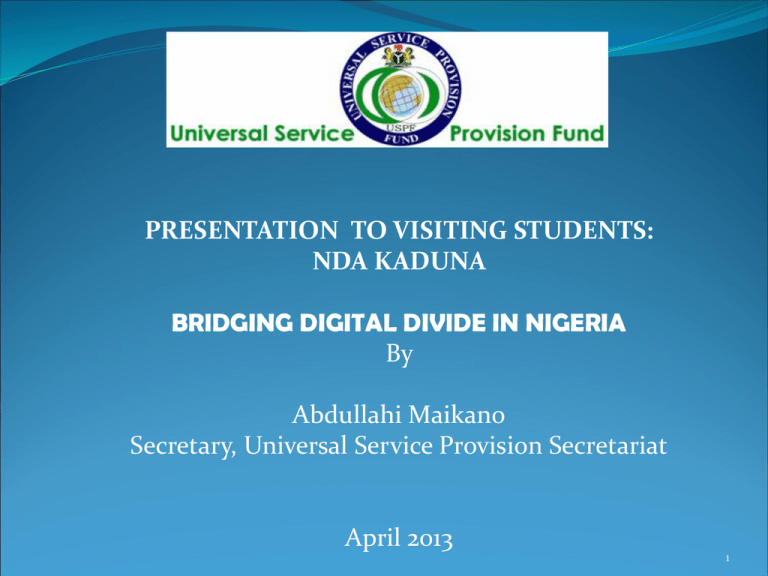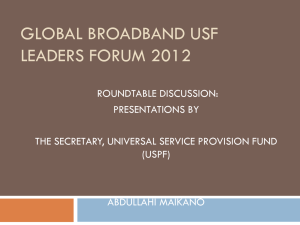Presentation to Visiting NDA Cadets
advertisement

PRESENTATION TO VISITING STUDENTS: NDA KADUNA BRIDGING DIGITAL DIVIDE IN NIGERIA By Abdullahi Maikano Secretary, Universal Service Provision Secretariat April 2013 1 CONTENT INTRODUCTION VISION/MISSION OF THE USPF GLOBAL PERSPECTIVE GOALS AND STRATEGY PROGRAMMES AND PROJECTS CONCLUSIONS 2 INTRODUCTION The Nigerian Communications Act (NCA) No 19 of 2003, Part IV detail the Universal Service Provision in Nigeria. Section 115 establishes the USP Board with the mandate to supervise and provide broad policy directions for the management of the USP Fund. Section 118 establishes the USP Secretariat and states that it shall reside in the Commission (NCC) and shall be responsible for the day-to-day administration of the Universal Service Provision. 3 INTRODUCTION The Universal Access and Universal Service Regulation 2007 Section (2) states that “The ultimate objectives of the system of universal access and universal service provision described in sub-paragraph (1) of the regulation are to: promote greater social equity and inclusion for the people of Nigeria; and Contribute to national economic, social and cultural development of Nigeria 4 INTRODUCTION The Universal Service Provision Fund (“USPF”) was established by the Federal Government of Nigeria to facilitate the achievement of national policy goals for universal service and universal access to information and communication technologies (ICTs) in rural, unserved and under-served areas in Nigeria. The USP Secretariat carries out the general statutory mandate of the NCC on Universal Access and Universal Service by: ‘… promoting the widespread availability and usage of network services and application services throughout Nigeria by encouraging the installation of network facilities and the provision of network services and applications services to institutions and in unserved, underserved areas or for underserved groups within the community’ 5 INTRODUCTION The core focus of the USPF mandate are: Widespread availability of infrastructure and services Usage of network and application services The USPF was established to bridge the Digital divide in Nigeria through its activities. Reducing economic barriers through widespread availability Eliminating Knowledge barriers through usage of networks and application services 6 VISION/MISSION OF THE USPF Vision Equitable ICT Access for All Mission To facilitate the achievement of universal access to ICT and universal service, through market-based investment, which stimulate development in rural, un-served and underserved communities. 7 GLOBAL PERSPECTIVE World Summit on the Information Society (WSIS) Digital Revolution – Advances in ICT resulted in fundamental changes in the way we communicate, work, earn a livelihood, and socialize/behave Digital Divide – The Digital Revolution created a divide between and within countries i.e. those that have access to ICT and have adopted ICT in improving lives and those that have no access to ICT WSIS developed a Plan of Action with Ten Targets: 1. to connect villages with ICTs and establish community access points; 2. to connect universities, colleges, secondary schools and primary schools with ICTs; 8 GLOBAL PERSPECTIVE 3. to connect scientific and research centres with ICTs; 4. to connect public libraries, cultural centres, museums, post 5. 6. 7. 8. 9. offices and archives with ICTs; to connect health centres and hospitals with ICTs; to connect all local and central government departments and establish websites and email addresses; to adapt all primary and secondary school curricula to meet the challenges of the Information Society, taking into account national circumstances; to encourage the development of content and to put in place technical conditions in order to facilitate the presence and use of all world languages on the Internet; to ensure that more than half the world’s inhabitants have access to ICTs within their reach. 9 Current Perspectives –SMP 2013-2017 Programs: •Backbone Connectivity •Local Access Network and Facilities •Accelerated Mobile Phone Expansion •Health Informatics •E-Accessibility •Local Content Development Programs: •Research Studies and Surveys •Subsidy and Incentive Design •Consultation and Awareness Creation Programs: •Review/Development of Organisational Capacity •Review/Development of Policies and Procedures Manuals •Review of Organisational Plans 10 GOALS AND STRATEGY The strategies: Grants and Subsidies through Public-Private- Peoples Partnerships (PPPP) are designed to achieve: AVAILABILITY: ICT services should be accessed by consumers every time (24×7), even if it is public access. AFFORDABILITY: Prices of ICT services (within a universal service programme) should be such that a greater part of the population can pay ACCESSIBILITY: The geographic distribution of ICT services points of presence should be as close as possible to the consumers, including persons living with disabilities. SUSTAINABILITY: ICT services/applications programmes shall be managed/maintained in ensures consumers benefit from the programme forever AWARENESS/EMPOWERMENT: UA/US within the UA/US a mechanism that over a long period - programmes are designed to promote awareness of the importance and uses of ICT. The programmes should also help improve the socioeconomic activities of the rural communities. 11 PROGRAMMES AND PROJECTS The USFP commenced operations in 2006. Over the past 5 years the following programmes and projects were undertaken: School Access Project (SAP) - This project ensure the USPF promotes e- learning in secondary schools by facilitating technology-enabled learning. Students are able to collaborate with other students and the teachers would be able to give each student the required attention. 1117 schools have benefitted from the project in the last 5 years Tertiary Institutions Access Project (TiAP) - This project ensure the USPF promotes e-learning in tertiary institutions by facilitating technologyenabled research and learning. The provision of internet access would support . 204 institutions have benefitted E-Library - The E-library Project is a platform to connect the existing libraries in the country to enable the sharing of information and other resources as well as connect to other libraries outside the country. 74 libraries have benefited from this initiative 12 PROGRAMMES AND PROJECTS CONTD Community Communications Center (CCC), The CCC is a community- based ICT centre that is set up to provide telephony and internet services as well as ICT-based training and other services on a shared basis. 195 Centres have been deployed in various communities. BTS Projects - This programme involves granting of subsidies for the deployment of Base Transceiver Stations (BTS) and other passive infrastructure in underserved and un-served communities in Nigeria to accelerated mobile voice and mobile broadband coverage via GPRS, EVDO, 3G, etc. 78 sites have been constructed by the various mobile operators. 13 PROGRAMMES AND PROJECTS CONTD. Rural Broadband Initiative (RuBI): This programme will result in the provision of Internet services and applications that would support socioeconomic activities in the unserved and underserved communities. The Rural broadband Initiative thus seeks to support the establishment of core delivery mechanisms for Broadband services in the rural / semi-urban areas of Nigeria. 18 pilot wireless mobile broadband hot spots are being constructed in the six geopolitical zones the country Backbone Transmission Infrastructure (BTRAIN): The Universal Service Provision Fund within this programme, provide incentives to industry operators to build out the optic fibre cable network from major cities/towns where they currently exist to surrounding communities which have been classified as unserved especially in terms of internet infrastructure. 500km of OFC is currently being deployed across the country 14 CONCLUSION The importance of ICT in improving lives has been globally acknowledged. Developing effective ways to extend access to telecommunication and ICT services to poor and remote communities and to the unserved and underserved areas of Nigeria in meeting the targets of WSIS Plan of Action is the challenge the USPF confronts. The low incomes, the small size of communities, and the large investments required because of the lack of infrastructure backbone (and in some cases difficult terrain) are all key issues in designing viable options for universal access. Through all of these, the goal of the USPF remains the same, simply to bridge the gap between the information rich and the information poor and to enable user-friendly and affordable access to ICT facilities and services for every Nigerian regardless of the region of the country they reside, hence creating an enabling environment to drive socio- economic development in the country. 15 CONCLUSIONS It is the belief of the USP Management that the World Summit of Information Society (WSIS) declaration – Everyone, everywhere should have the opportunity to participate and no one should be excluded from the benefits the Information Society offers – is attainable in Nigeria. The digital divide can be bridged and Nigeria can be transformed into digital economies like in India, Japan, Singapore and Malaysia. It is our believe that Nigeria’s youth MUST be equipped with appropriate ICT skills to enable them compete favorably with their contemporaries anywhere in the world. 16 Please visit our website: www.uspf.gov.ng for additional information 17





